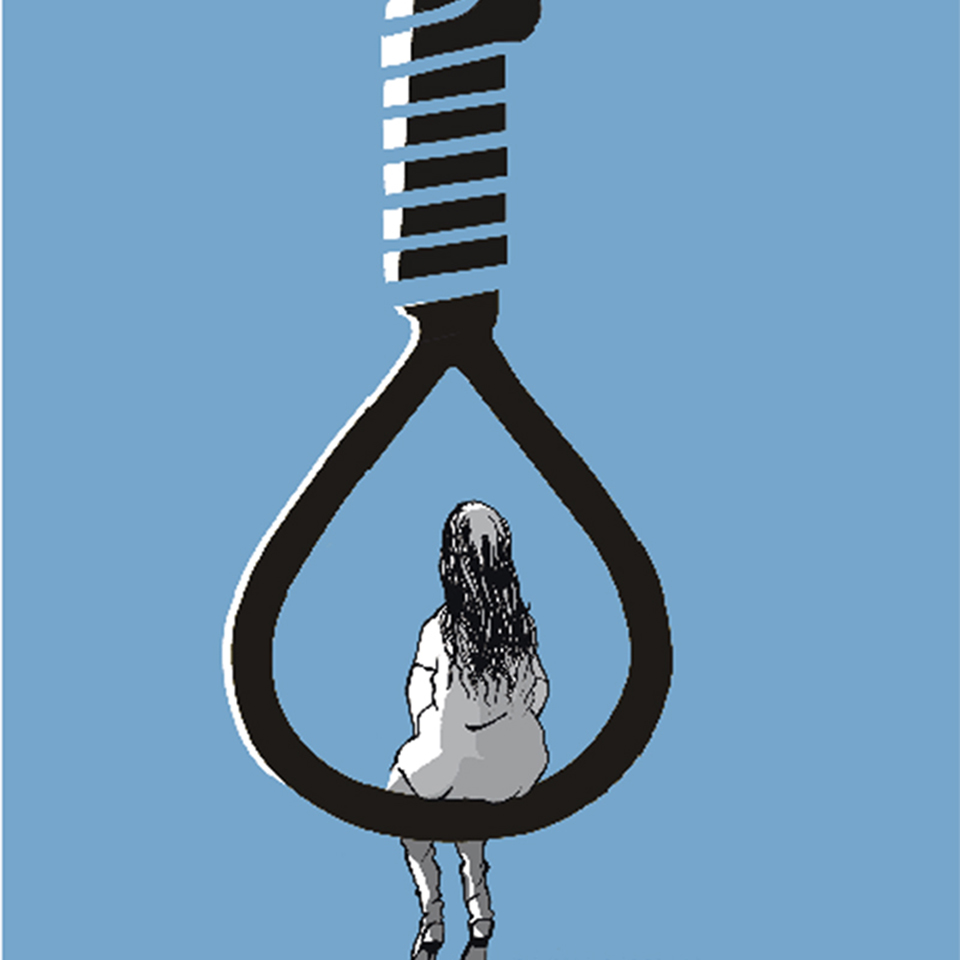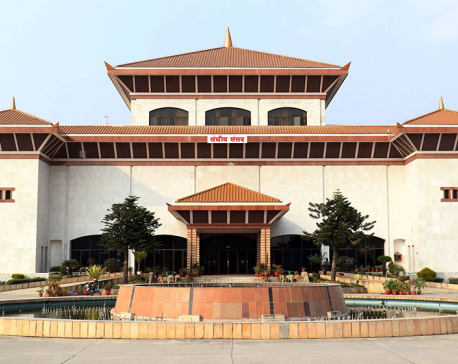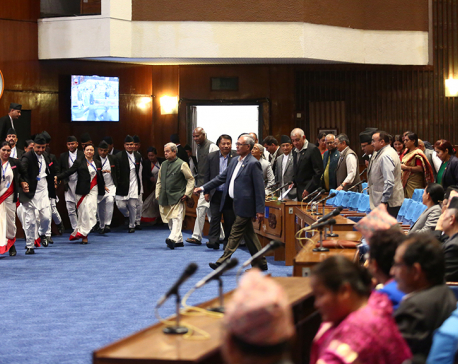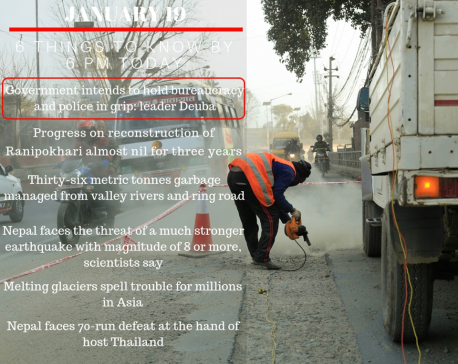
OR
Teenage suicides up, govt a passive spectator
Published On: August 15, 2019 07:20 AM NPT By: Aditi Baral

KATHMANDU, Aug 15: Recent reports of young people committing suicide have grabbed national headlines. Although a lot of schools and colleges are taking significant steps to help their students by hiring student counselors and child physiologists, 'teen suicides' are only going up. More than 50 percent of suicide victims are youths (ages 15-30 years), according to the latest figures compiled by Nepal Police.
Research shows that in most of the Asian countries, including Nepal, acute life stress relating to social, economic, traditional and cultural issues play a huge role in rising suicides among teens.
According to a study conducted by the Center for Medical Health and Counseling-Nepal (CMC-Nepal) back in 2012, Nepal ranked 7th globally in suicide rates -- around 7,000 people commit suicide every year, which is 25 people per 100,000. More than 50 percent of those committing suicide age between 15 and 40, according to the CMC-Nepal study. More alarming, Nepal ranks 17th in terms of male suicide rate and third in female suicide rate in the world, according to the study.
One of the 'easy to speculate' risk factors for such a high suicide rate in the state of mind. Research shows that in most of the Asian countries, including Nepal, acute life stress relating to social, economic, traditional and cultural issues play a huge role in rising suicides among teens.
The recent death of an 18-year-old Yubak Lama is a case in point. Lama was a single-legged boy who was a famous young cycling enthusiast. He hanged himself to death in his room at Hattiban in Lalitpur on August 4. Just a couple of hours before the tragedy, he had posted a picture of himself in tears with a caption that read: “I shall meet you in another life, please forget me for now.”
Lama's last picture and the caption indicate that he was going through a difficult time. That was not the first indication of Lama's struggles. He had been posting pictures with similar captions that directly indicated that something was wrong.
In February 2019, Anjali Chauguthi, 19-year-old girl, of Bhaktapur -3 was found dead, hanging from the ceiling.
A study by CMC further says that postmortem reports of suicide cases show hanging as the most common way of committing suicide across all age groups. A recent data from Nepal Police say 73 percent of the suicide cases involved hanging, followed by taking poison (22 percent).
Jagannath Lamichhane, a mental health activist, says that “One of the reasons that escalate suicides among teens is the lack of understanding about the physical and mental changes that occur in them during teenage years. When these changes occur, teenagers expect someone to stand for them, in order to explain all of it and to let them know that it is natural and acceptable. In the absence of such guidance, they tend to take wrong steps.”
He further mentioned that social media also stands as a 'provoking factor' for teen suicides. A lot of unnecessary comparisons and complications that come along with the massive use of social media cannot be ignored. Many teenagers are harassed and humiliated on social media, leading to low self-esteem. The ones facing problems do not dare to share with others. Gradually such emotions get piled up, which then leads to 'mental illnesses' and 'depression'.
In 2016, Sushanta Mainali, 16, committed suicide by hanging in his school's toilet in Basundhara, Kathmandu. According to reports, Mainali was not on good terms with his father. He had conversations with his father over the phone for about four minutes the day before he killed himself.
Similarly, in May 2018, two teenage girls, who were best friends, committed suicide in Mahottari district. They killed themselves by consuming pesticide. According to a source, Chandani Kumari Jha, 15, and Khusi Kumari Chaudhary, 16, killed themselves just because both of them had minor arguments with their mothers.
And Samir Lungwa, 11, from Lalitpur committed suicide on June 22, 2019, at his home. He was studying in grade 5 and wrote a note saying he was bullied both at home and school.
Basudev Karki, a psychiatrist at Patan Mental Hospital, says that a lot of these cases of teenagers being mentally disturbed or depressed are due to the lack of communication between children and parents. Working parents barely allocate time for their children to hang out with them and listen to their stories.
Experts fear that the suicide rate in Nepal could be higher than reported. In many cases, the families of suicide victims do not even report to the police for the fear of losing 'family dignity' and legal complications.
Despite rising suicides, the Nepal government has done little to help teenagers. While a few mental health awareness campaigns have been organized once in a while, no other 'suicide prevention strategy' has ever been implemented. Dr Vasudev Uphadhya, director-general of the Department of Health Services, says that the government has allocated some money to initiate awareness programs and health camps at local levels to educate people about mental health.
“The government is specifically focusing on Province 2 and Far Western region for the initiative. We want to start mental health camps within this fiscal year,” Uphadhya said.
However, these efforts seem too little compared to the ever-increasing teen suicides. In order to prevent suicide and help teenagers, experts suggest that parents must start investing time in their children -- interact with the children. Also, experts suggest that information about suicide prevention hotlines must be circulated, along with awareness on mental health and its importance, starting from primary school. The hotline number for Suicide Prevention Helpline Nepal is 9840021600.
You May Like This

House committee urges govt to reconstruct disaster-hit infrastructures at earliest
KATHMANDU, Aug 11: Parliament's Development Committee has directed the government to start the reconstruction of roads and bridges that were damaged due... Read More...

Opposition accuses speaker of working at govt's behest
KATHMANDU, July 11: Opposition parties have accused Speaker Krishna Bahadur Mahara of working at the behest of the government after the... Read More...

Jan 19: 6 things to know by 6 PM today
Your daily dose of missed important news of the day. ... Read More...



Just In
- World Malaria Day: Foreign returnees more susceptible to the vector-borne disease
- MoEST seeks EC’s help in identifying teachers linked to political parties
- 70 community and national forests affected by fire in Parbat till Wednesday
- NEPSE loses 3.24 points, while daily turnover inclines to Rs 2.36 billion
- Pak Embassy awards scholarships to 180 Nepali students
- President Paudel approves mobilization of army personnel for by-elections security
- Bhajang and Ilam by-elections: 69 polling stations classified as ‘highly sensitive’
- Karnali CM Kandel secures vote of confidence















Leave A Comment